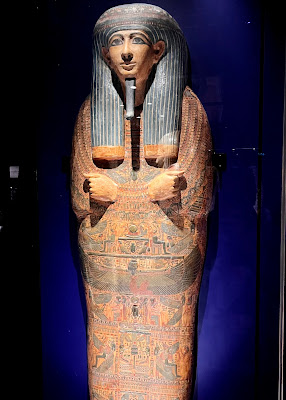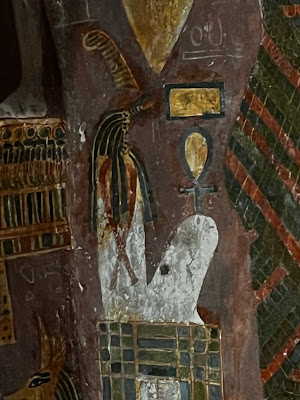I admit to some unease about this bit. As explained (in detail) in my previous post, the Egpytians put a great deal of belief in the afterlife and took great pains to ensure that they were well provisioned for it and would enjoy it to maximum effect. And then later, various civilisations (including the Dutch, from whence this exhibition originates) came and excavated/ raided them and their treasures and put them on display for us to ogle.
While I admire the artefacts and objects, I feel quite conflicted about the cartonnages and the bodies themselves. I would like them to rest in peace and know that their efforts to support themselves in the next life were not in vain, and yet I am guilty of paying to see them to learn more about their culture and gain information. So I am part of the problem.
This area in the Discovering Ancient Egyptian exhibition was partitioned with a warning. Various cultures have a taboo about displaying dead people. There is good reason for this. So this Friday Five is like a sealed section.There are no pictures of the human remains themselves.
Coffins and cartonnages protected a person's mummified body both physically and magically, allowing the spirit, or ba manifestation, to travel between the world of the living and the afterlife. They were often elaborately painted with spells, symbols and gods to safeguard the deceased person on their journey to the afterlife. The study of coffins and cartonnages helps us to understand how and why ancient Egyptian burial practices developed and changed over time.
In later periods of Egyptian history, mummified bodies were placed inside cartonnage coffins in addition to inner and outer coffins. The term 'cartonnage' is used for both the technique of constructing these pieces, as well as the pieces themselves. Cartonnage is a method similar to papier-mâché, but with layers of linen instead of paper, along with glue and stucco (plaster). Perhaps these relatively fragile coffins became popular because they were difficult to open without damaging them, which meant they were heardly ever reused. This would ensure that the mummified body was more likely to remain with its original cartonnage coffin (until it was dug up and put on display in a museum).
1. This coffin once held the body of Haytemhat, a wealthy woman from a priestly family. The front and back of the coffin are filled with hieroglyphic texts containing spells and formulae, along with depictions of many gods. The sky goddess Nut is shown spreading her wings over Haytemhat's chest to give her magical powers. Haytemhat's coffin was created with care, with every hieroglyph executed in meticulous detail.
 |
| Coffin of Haytemhat (Late Period, c.722-332 BCE) |
 |
| Proof of Time Travel: King Charles III hieroglphy |
 |
| Inner Coffin of Amenhotep (21st Dynasty c.1076-944 BCE) |
Depicted on the inside of the coffin's base is the goddess Hathor, ready to embrace the desceased. She is surrounded by images of the four sons of Horus and a cow, the animal associated with Hathor. At the head end of the coffin, the ba, or soul, of Amenhotep is depicted in the form of a bird with a human head.
3. This coffin belonged to Hor, a priest of Amun and a son of Asettefnakht, who was a young man at the time of his death.The four figures are the sons of Horus, who protected a dead person's organs. The scene below the collar shows the weighing of Hor's heart at the judgement of Osiris. Both the text and the images ensure that Hor will arrive safely and survive in the afterlife. On the inside of Hor's coffin, a protective goddess holds an ankh sign, symbolising life, in both hands.
 |
| Outer coffin of Hor (25th Dynasty, c.722-655 BCE) |
4. This inner coffin of Khonsuhotep, priest of the gold-workers in Horemheb's temple domain, is decorated inside and out to show him in the company of various gods. The lid shows Khonsuhotep wearing a duplex wig with a decorative band. In four scenes below the centre of the lid, he wears a festive dress while visiting the shrines of the gods in the afterlife. The winged goddess Nut depicted on the inside of the coffin protects Khonsuhotep's head.
 |
| Inner coffin of Khonsuhotep (Third Intermediate Period, c.1076-944 BCE) |
 |
| 'Mummy cover' of Khonsuhotep |
5. This cartonnage, made from layers of linen, glue and stucco, provided a snug-fitting inner coffin for the mummified body of Nehemsu.
 |
| Cartonnage of Nehemsu (22nd Dynasty c..943-746 BCE) |
6. This outer coffin, crafted for Panesy, a priest from Thebes, features remarkable iconography and materials designed to protect and honor the deceased. On each side, the four sons of Horus stand prominently in the lower section, symbolizing the gods who guard the internal organs following mummification. Panesy’s face was carved separately from a higher-quality wood, left unpainted to showcase its craftsmanship. The eyebrows, set with a second wood type, possibly ebony, and inlaid ivory or bone for the eye whites, add distinct refinement. Within the coffin’s interior, Nut, the sky goddess, is depicted, embodying themes of rebirth and the sun’s eternal cycle—echoing Panesy’s journey into the afterlife.
 |
| Outer Coffin of Pansey (22nd Dynasty c.943-746 BCE) |
This burial jar is decorated with a face and two hands and has an opening at the back. It may have been used for the burial of a premature baby. Although no parallels for this type of jar are known to exist, it may be related to the practice of burying children and adults in ceramic coffins decorated with faces. This type of coffin was adopted in Egypt from the Near East.
 |
| Ceramic Burial Jar (Late Period, c.722-332 BCE) |
Elements such as hands, faces, eyes, wigs and beards were often created separately and attached with dowels or dovetails to the coffin lid or, in the case of eyes, individually inlaid. These pieces were easily changed if the coffin was later reused. The style of hands, for example, represented a person's gender: men had closed fists, women had extended fingers.
The face, beard and wig were sometimes made from high-quality wood and left unadorned to reveal the beauty of the grain. This gilded cartonnage mask was placed over the face of a mummified person's body. It depicts them in an exalted state in the afterlife.
 |
| Gilded Mask (Ptolemaic Period, 304-30 BCE) |




















No comments:
Post a Comment